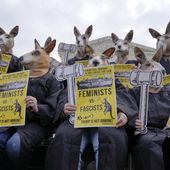CHICAGO — For more than a century, Archbishop Quigley Preparatory Seminary has prepared teenage boys for the priesthood. It remained largely unchanged as the city transformed around it from gritty industrial center to modern metropolis.
But another kind of change finally caught up with Quigley.
The 102-year-old seminary — a Gothic-style building in a tony Chicago shopping district — closes Friday because of its shrinking student body that has seen just one graduate ordained in the past 17 years.
It’s the latest reminder that Roman Catholic preparatory seminaries have all but vanished in the United States and highlights the church’s struggle to find men willing to dedicate themselves to the priesthood.
“This is more or less the final nail in the coffin of the preparatory seminary,” said R. Scott Appleby, a historian at the University of Notre Dame who has written extensively about the church.
“Historians of the Catholic Church will point to the closing of Quigley … as a final landmark in a trend that has been building now for almost 50 years,” he said.
As recently as the late 1960s, there were 122 high school seminaries in the U.S. with a combined student body of nearly 16,000, according to the Center for Applied Research in the Apostolate at Georgetown University.
Quigley, which counts New York Cardinal Edward Egan and Atlanta Archbishop Wilton Gregory among its alumni, was bursting with about 1,300 students in the 1950s; it had just 183 at the beginning of this school year. When Archdiocese of Chicago officials announced in September that the school would close, they said it would be $1 million in debt by June.
Its closure will leave just seven preparatory seminaries with a combined enrollment of about 500 students in the United States. The number of priests in the United States has dropped from nearly 59,000 in 1975 to about 42,000 last year.
The decline of high school seminaries illustrates a dramatic shift in the way the church finds priests — and how it’s had to scramble to do so.
Parishes increasingly are being served by priests from foreign countries, in large part because fewer American men are becoming priests. At the same time, the average age of new priests is older, with many men waiting until their 30s, 40s and beyond.
When 13 priests were ordained last month in Chicago, all but one was born and raised in another country, with most attending college before they came to the United States. Nine of them were in their 30s and the lone American-born priest was a 42-year-old former advertising executive.
The reasons for the shift begin with how dramatically things have changed since Quigley opened in 1905.
Quigley, which moved to its present home in 1918, like other seminaries thrived because large Catholic families, many Irish or Polish, often sent at least one of their sons there.
“In the old days you had an Irish family with three kids. One was going to be a priest, one was going to be a cop and one was going to be a fireman, and the mother was going to be the one who decided which was which,” said Peter Makrinski, a longtime teacher and coach at Quigley.
That began to change in the 1960s and ‘70s. Archdiocese spokesman James Accurso said that seminaries fell out of favor among young people for the same reason marrying right out of high school did.
“A lot of things in life are delayed, young people get married later and I think they join the priesthood later,” he said.
Morgan Mellske, an 18-year-old Quigley senior, said that, while some students are considering becoming priests, most are not.
“I don’t even know what I want to do with the rest of my life,” he said. “People become priests in the middle of their life.”
Mr. Appleby, the historian, said there’s more to it.
“It’s a culture that raises a collective eyebrow at the notion of a young man or a young woman (who) would renounce sexuality or sexual self-expression,” he said. “There’s a general skepticism about the emotional health of people who would do that voluntarily,” particularly, he said, at such a young age.
Within the church itself, more people began questioning the wisdom of training teenagers to become priests and forgo sex.
“Our understanding [of sexuality] is more developed today,” explained the Rev. Donald Cozzens, a professor at John Carroll University in Cleveland and a former seminary rector who criticized mandatory celibacy in a book, “Freeing Celibacy.”
Furthermore, as families shrank, so did the pool of prospective seminarians.
“When they don’t have more than one boy, parents are very reluctant to let that child go into the priesthood,” said Sister Katarina Schuth, a teacher at the University of St. Thomas in Minnesota, who has studied seminaries for more than two decades.
Even families that continued to send their sons to Quigley made it clear that they were doing so for the Catholic education and not to start them on a path to priesthood.
“The parents, they want their sons to make money, they want their sons to get married,” Makrinski said. “They’d say, ‘I’d much rather see them get a job.’ ”
While more than 3,000 young men have graduated from Quigley in the past 17 years, just one has been ordained. That was in 1999.



Please read our comment policy before commenting.